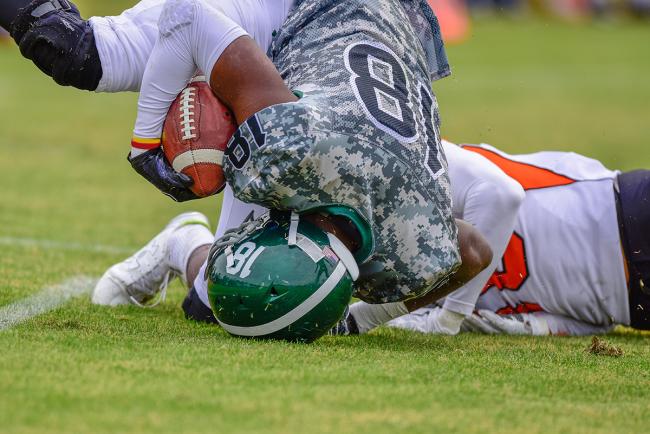How football raises the risk for chronic traumatic encephalopathy
July 11, 2023
How football raises the risk for chronic traumatic encephalopathy
At a Glance
- The force of blows to the head that football players experienced over their lives better predicted chronic traumatic encephalopathy than the number of concussions.
- A better understudying of the causes of this deadly type of neurodegenerative disease could help change how football players practice and play.

Blows to the head during contact sports like football, boxing, and soccer can cause injury to the brain, called traumatic brain injury. Studies of American football players have identified a serious consequence of repeated traumatic brain injuries. In a condition called chronic traumatic encephalopathy, or CTE, tangles of a protein called tau build up in the brain after repeated head impacts. The resulting brain damage is similar to that seen in Alzheimer’s disease. CTE can lead to dementia and eventually death.
To help prevent CTE in people who play contact sports, scientists are investigating the types of head impacts that confer the most risk. An NIH-funded research team led by Dr. Daniel Daneshvar from Massachusetts General Hospital and Dr. Jesse Mez from Boston University set out to better understand the relationship between head impacts and CTE.
The team collected data from 34 previous studies of helmet accelerometers used in youth, high school, and college football players. These devices measure the number, speed, and direction of impacts to the head during play. The researchers used this data to create what they called a positional exposure matrix, or PEM. This estimated the average number and types of blows to the head a person would experience during a season for a particular playing position and level of play, including professional athletes.
The team then looked at the relationships between these estimated impacts and CTE in 631 male brain donors who had previously played football. Results were published on June 20, 2023, in Nature Communications.
On average, the brain donors had played about 12 years of football and died at age 60. About 28%, or 180 of them, didn’t have evidence of CTE in their brains. Another 163 had low-stage CTE, and 288 had high-stage CTE. As seen in previous studies, the number of reported concussions wasn’t associated with CTE incidence or severity.
However, the number of years playing football as well as several factors measured by the PEM were associated with CTE. Every additional year playing football was associated with 15% increased odds of a CTE diagnosis and, for those with CTE, 14% increased odds of severe CTE.
Every 1,000 additional estimated blows to the head conferred 21% increased odds of a CTE diagnosis, and 13% increased odds of developing severe CTE. Analyses that took into account the linear and rotational accelerations experienced during head blows were better at predicting CTE than models that only included the number of blows.
These associations held when the researchers took other potential sources of head injury over a lifetime into account. These included military service and other contact sports.
“These results provide added evidence that repeated non-concussive head injuries are a major driver of CTE pathology rather than symptomatic concussions,” Mez says.
“This study suggests that we could reduce CTE risk through changes to how football players practice and play,” adds Daneshvar. “If we cut both the number of head impacts and the force of those hits in practice and games, we could lower the odds that athletes develop CTE.”
—by Sharon Reynolds
Related Links
- Testing a Blood Biomarker for Neurodegeneration
- Nanoparticles Developed for Traumatic Brain Injury
- Biomarkers Predict Concussion Recovery Time
- Blood Proteins Associated with Persistent Symptoms after Brain Injury
- Tiny Bleeds Associated with Disability after Brain Injury
- Many with Mild Traumatic Brain Injury Don’t Receive Follow-up Care
- Predicting Recovery Time for Sports Concussions
- Caring for Concussions: More Than a Bump on the Head
- Traumatic Brain Injury (TBI)
- What Is Dementia?
- Brain Donation: A Gift for Future Generations
- NIH NeuroBioBank—Why Donate?
References
Leveraging football accelerometer data to quantify associations between repetitive head impacts and chronic traumatic encephalopathy in males. Daneshvar DH, Nair ES, Baucom ZH, Rasch A, Abdolmohammadi B, Uretsky M, Saltiel N, Shah A, Jarnagin J, Baugh CM, Martin BM, Palmisano JN, Cherry JD, Alvarez VE, Huber BR, Weuve J, Nowinski CJ, Cantu RC, Zafonte RD, Dwyer B, Crary JF, Goldstein LE, Kowall NW, Katz DI, Stern RA, Tripodis Y, Stein TD, McClean MD, Alosco ML, McKee AC, Mez J. Nat Commun. 2023 Jun 20;14(1):3470. doi: 10.1038/s41467-023-39183-0. PMID: 37340004.
Funding
NIH’s National Institute of Neurological Disorders and Stroke (NINDS), National Institute on Aging (NIA), Eunice Kennedy Shriver National Institute of Child Health and Human Development (NICHD), and National Center for Advancing Translational Sciences (NCATS); Department of Veterans Affairs; Department of Defense; Alzheimer’s Association; Nick and Lynn Buoniconti Foundation; Concussion Legacy Foundation; Andlinger Foundation; World Wrestling Entertainment, Inc.


